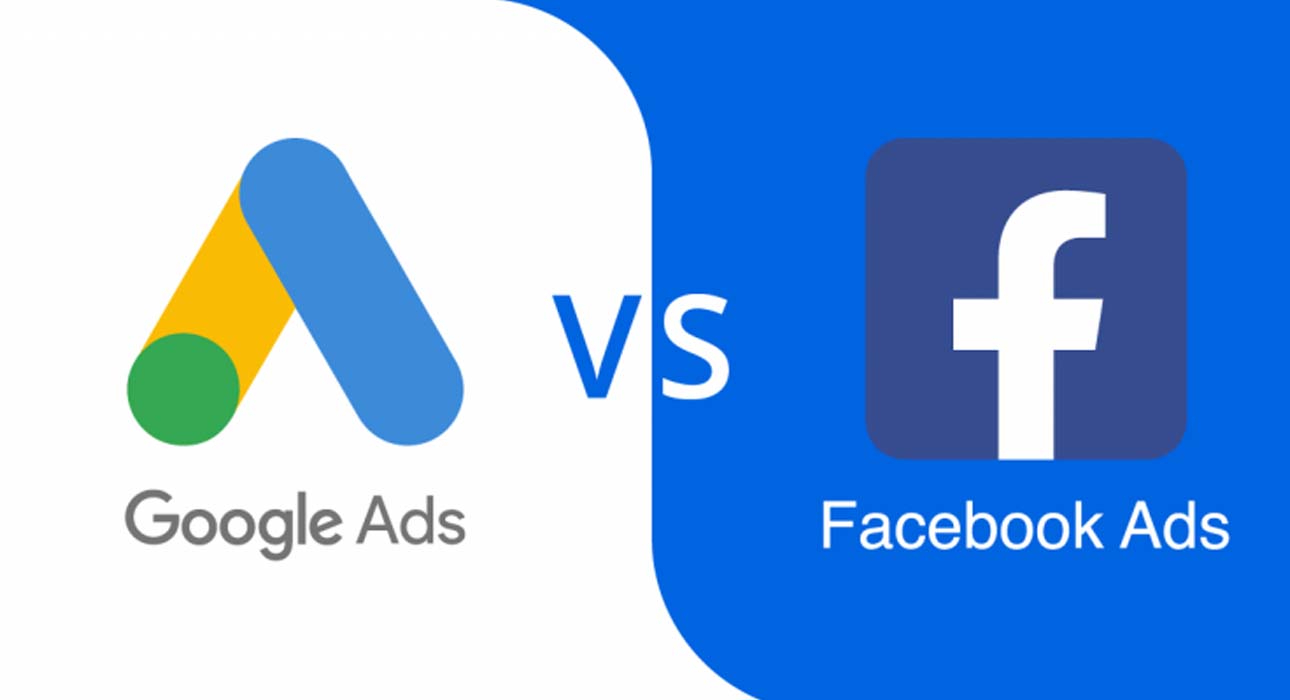By Sakhi Rughani 17 Oct 2024
GOOGLE ADS VS. FACEBOOK ADS: A COMPLETE COMPARISON

Introduction
It is very essential to choose the correct advertising platform to ensure the success of your business in this modern world of digital marketing where every brand is trying to build a strong presence online. Google Ads and Facebook Ads remain the top platforms available for businesses looking to maximize their reach and ROI. Understanding the strengths as well as differences between these two platforms to conclude which is the best to invest their ad spend into can be highly beneficial for businesses.
This blog will dive into Facebook and Google ads, providing a complete comparison of their unique features, target audience, cost and performance, to help the readers decide which suits best for their marketing needs.
1. What are Google Ads and Facebook Ads?
Before we begin the comparison, it's essential to understand what both platforms offer:
1. Google Ads (formerly known as Google AdWords) is a pay-per-click (PPC) platform that allows businesses to advertise on Google’s search engine results pages (SERPs), display networks, and YouTube. When someone searches for specific keywords, Google displays relevant ads based on the user's search intent.
2. Facebook Ads, on the other hand, is a social media advertising platform that allows businesses to advertise within Facebook’s ecosystem, which includes Instagram, Messenger, and the Audience Network. Facebook Ads are shown based on user demographics, interests, behaviors, and engagement, rather than search intent.
While both platforms are excellent for digital advertising, they have unique advantages that can benefit different types of businesses depending on the campaign goals.
2. Targeting Options
The way Google Ads and Facebook Ads target audiences is one of their main distinctions.
1. Primarily, intent-based targeting is used in Google Ads. This implies that advertisements are displayed to users while they are actively conducting a Google search. For instance, Google will show relevant advertisements from companies that offer running shoes if a user types in "buy running shoes online." Considering that consumers are frequently nearing the conclusion of their purchasing process, Google Ads are therefore an excellent means of obtaining leads at the bottom of the sales funnel.
2. Facebook Ads, on the other hand, uses interest-based targeting. Facebook collects a wealth of data from its users based on their profiles, activities, and interactions. Advertisers can target people based on their age, location, interests, behaviors, and even life events. Facebook is highly effective for reaching potential customers who may not be actively searching for a product but match a business’s ideal customer profile.
In summary, if you want to target users who are actively searching for a product or service, Google Ads is the better option. However, if you want to increase brand awareness and reach people based on their interests, Facebook Ads may be more effective.
3. Cost Comparison
Both platforms operate on a pay-per-click (PPC) model, but the cost-per-click (CPC) and cost-per-thousand-impressions (CPM) vary depending on factors such as industry, competition, and targeting.
1. Google Ads CPC can be higher due to the competitive nature of search advertising. Since Google Ads primarily targets users with strong purchase intent, businesses are willing to pay more for a click. On average, CPC for Google Ads can range from 1 to 2 dollars, but it can be significantly higher in industries such as legal, insurance, and finance, where CPCs can reach 50+ dollars.
2. Facebook Ads CPC tends to be lower than Google Ads, with an average CPC of around 0.50 to 1.50 dollars. Facebook Ads focus more on creating brand awareness and engaging potential customers early in their buying journey, which generally results in lower costs. However, if you're targeting a highly specific audience or running campaigns in a competitive niche, the CPC can still rise.
When it comes to CPM (cost per thousand impressions), Facebook Ads often offer a better value. The CPM for Facebook Ads ranges from 7 to 10 dollars, making it an ideal platform for businesses looking to reach a broad audience on a budget.
4. Ad Formats and Placements
Another key factor in the Google Ads vs. Facebook Ads debate is the variety of ad formats and placements offered by each platform.
1. Google Ads offers several ad formats, including:
a. Search ads: Text-based ads that appear on Google’s SERPs.
b. Display ads: Image or video-based ads that appear on websites within the Google Display Network.
c. Shopping ads: Product-based ads that appear in Google’s Shopping section.
d. YouTube ads: Video ads that appear before, during, or after YouTube videos.
e. App promotion ads: Ads specifically designed to promote mobile apps.
These ad formats allow businesses to engage with users in different ways, depending on the campaign objective. For instance, search ads are ideal for capturing high-intent users, while display and YouTube ads are better for building brand awareness.
2. Facebook Ads offers a similarly diverse set of ad formats, including:
a. Image ads: Static ads that appear in users’ feeds or sidebars.
b. Video ads: Short or long-form video ads that play automatically in the user’s feed.
c. Carousel ads: Ads that showcase multiple products in a single ad unit.
d. Slideshow ads: Lightweight video ads made from static images.
e. Stories ads: Full-screen vertical ads that appear between user-generated stories on Facebook or Instagram.
f. Messenger ads: Ads that appear directly within the Messenger app.
Facebook’s ad formats are designed to engage users in a more immersive and interactive way. For brands looking to build relationships with potential customers through storytelling and creative visuals, Facebook Ads offers a wider variety of engaging ad types.
5. Conversion Tracking and Analytics
Both Google Ads and Facebook Ads offer robust tracking and analytics tools, which allow marketers to monitor performance and optimize campaigns for better results.
1. Google Ads integrates seamlessly with Google Analytics, giving you access to detailed data on how users interact with your website after clicking on your ads. You can track key metrics such as click-through rates (CTR), conversions, and bounce rates. Google Ads also offers tools such as conversion tracking and remarketing, which allow you to retarget users who have already visited your website.
2. Facebook Ads provides a similar suite of tracking tools, including the Facebook Pixel. This small piece of code, when installed on your website, allows you to track user behavior, conversions, and remarketing opportunities. Facebook also provides Audience Insights, a tool that helps you understand the demographics and behaviors of your target audience, which can be invaluable for refining your campaigns.
Which Platform is Better for You?
The choice between Google Ads and Facebook Ads ultimately depends on your business goals, target audience, and budget.
1. Google Ads is better suited for businesses looking to capture high-intent customers who are actively searching for specific products or services. It’s ideal for lead generation, e-commerce sales, and businesses in competitive industries where intent is crucial.
2. Facebook Ads is a great choice for businesses that want to build brand awareness, engage with users through storytelling, and target customers based on their interests and behaviors. It’s particularly effective for B2C businesses and industries such as fashion, beauty, and lifestyle.
Conclusion
While both Google Ads and Facebook Ads offer advantages, which one is best for your business will be determined by your target audience and campaign objectives. Facebook Ads thrives at creating engaging, interest-based ads that target people at various stages of the buyer journey, whereas Google Ads excels at acquiring high-intent visitors via search.
Organizations may benefit from integrating the two platforms. By combining Google Ads for search intent and Facebook Ads for audience engagement, you can develop a comprehensive digital marketing plan that maximizes ROI and ensures long-term growth.




